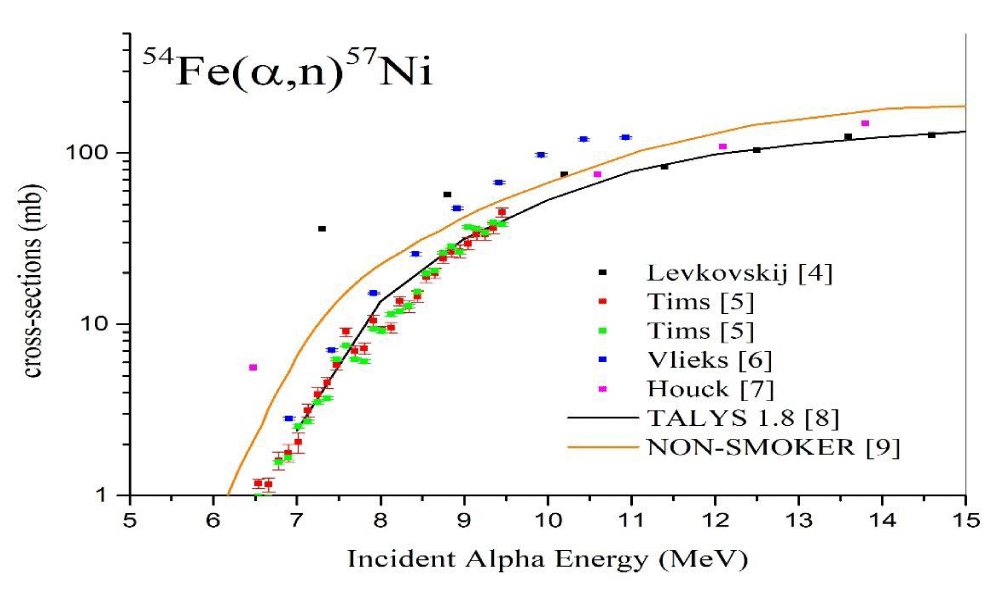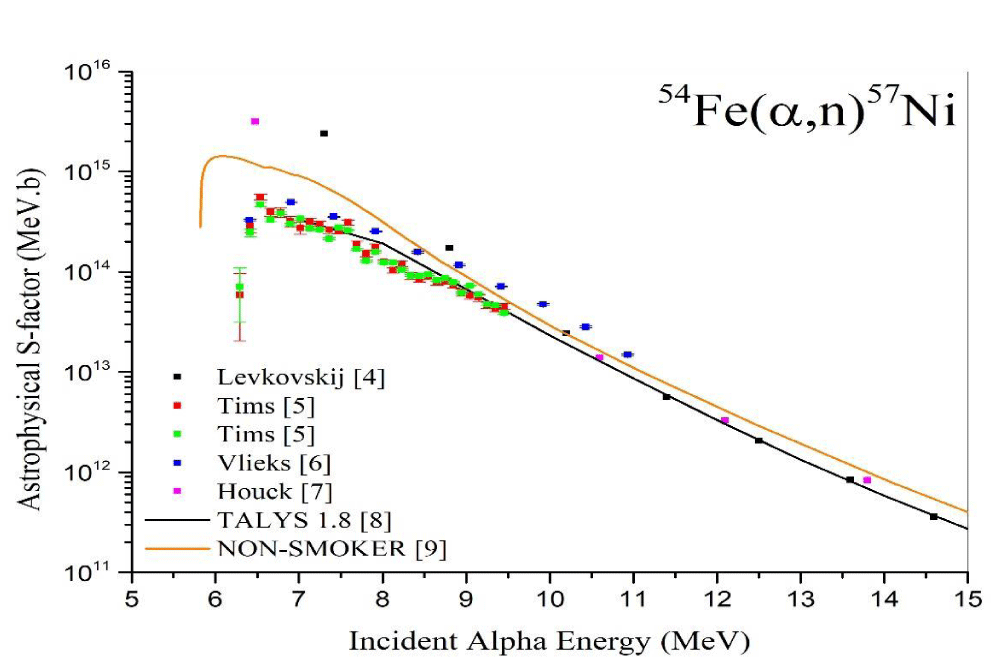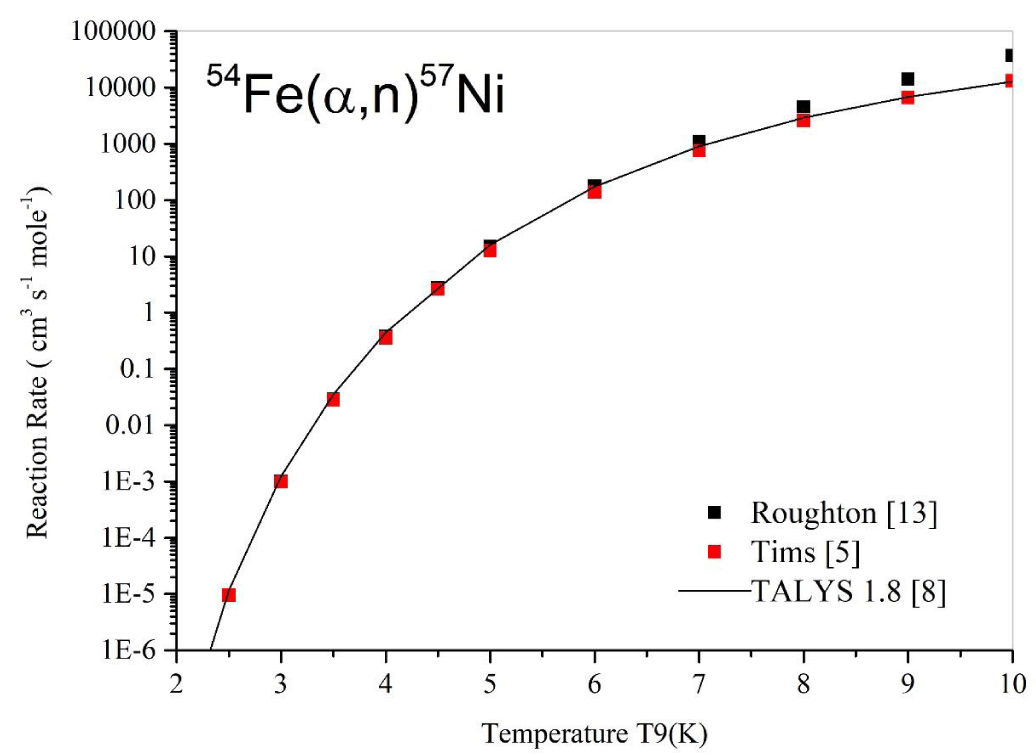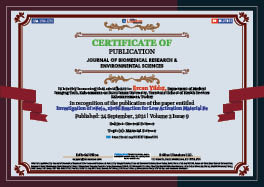> General Science. 2021 September 24;2(9):826-829. doi: 10.37871/jbres1316.
Investigation of 54Fe(α, n)57Ni Reaction for Low Activation Material Fe
Ercan Yildız1* and Saniye Tekerek2
2Department of Optician, Kahramanmaras Sutcu Imam University, Vocational School of Health Services, Kahramanmaras, Turkey
- Low activation materials
- TALYS
- NON-SMOKER
- EXFOR
Abstract
In fusion reactors, radioactivity can be controlled by effective material selection. Material selection is always important for efficient conversion of radioactivity to electrical energy.The selection of structural materials provides more efficient use of these structural materials with the results obtained from nuclear reactions. Low activation materials not only high in structural material performance and longer life, but also minimize related problems. Iron is an important element in fusion reactor technologies and astrophysical applications. For this reason, we obtained the theoretical cross-section values of the 54Fe(α, n)57Ni reaction in the range of 5-15 MeV (Mega electron volt) in this study. TALYS 1.8 (nuclear model code system) and NON-SMOKER (computer code) were used for theoretical calculations. Astrophysical S-factor values describing reactions at low energies were also calculated. In addition, reaction rate values were calculated with TALYS 1.8 and compared with EXFOR (experimental nuclear reaction data).
Introduction
Fusion energy production and development of these production mechanisms the resistance of the materials to high temperatures and radiation damage is very important. One of the characteristics that materials to be used in fusion reactors must have to protect them from the effects of radiation is that they have low activation, according to the available data, C (Carbon), Si (Silicon), Ti (Titanium), Fe (Iron), Cr (Chromium) and V (Vanadium) are considered low activation elements. Studies have always focused on the compatibility of the alloy using structural material based on low activation material to minimize the effect of high activation elements. However, it is not always possible to completely eliminate the high activation elements, either due to limitations in metallurgical processes to maintain mechanical or properties or to manufacture structural materials [1]. The question is whether the perceived advantages of a lower activation design can be achieved in a reliable engineering system [2].
The experimental measurements model theory calculations and systematic forecast are rather useful to provide this information, particularly for predicting the cross-sections of nuclear reaction [3]. Therefore, recently 54Fe(α, n)57Ni cross-sections are measured by several authors [4-7]. When the authors pay particular attention to figure 1, cross-section values in the range of 6-10 MeV were observed intensely.
Theoretical calculations, we used TALYS 1.8 [8] and NON-SMOKER [9] codes. Results of our calculations were checked to the experimental data obtained from EXFOR [10] database.
Materials and Methods
The astrophysical S-factor is defined as;
S(E) = σ(E).E.exp(2πη) (1)
Where, η is the sommerfeld parameter, (Z1Z2e2)/ħν. The astrophysical S-factor is especially helpful in low energy regions. Empirical measurements of σ (E) are often not available in measuring these energies [11].
Thermonuclear reaction rate formula can be expressed in equation 2 [12].
Where NA is Avagadro’s number, m is reduced mass and E is centre-of-mass energy, and T indicates temperature of the environment fort the reaction.
TALYS (Nuclear Reaction Code)
The TALYS 1.8 [8] nuclear code program determines all reaction mechanisms, reaction channels and all observable possibilities using nuclear models. In the simulation reactions created in this program.
NON-SMOKER
NON-SMOKER [9] is a computer code using the Hauser-Fesbach Model that theoretically calculates cross section values.
EXFOR
EXFOR [10] data library is a comprehensive collection of experimental nuclear reaction data, stored and reused. EXFOR web database access system;It has many services such as data search, output in various formats, drawing comparison with ENDF (evaluated nuclear data file), reorganize old data to new standards, inverse reactions and calculating data, creating correlation matrices from partial uncertainties.
Results and Discussion
Figure 1 was examined, experimental cross section values, especially in the range of 7-10 MeV, were compatible with the TALYS 1.8 and NON-SMOKER. Levkovskii [4] values and TALYS 1.8 values are almost the same in the range 5-15 MeV. TALYS 1.8 and NON-SMOKER values are in great similarity in the graph. After 10 MeV, the experimental data decreased and the Houck [7] values in the 10-15 MeV range are quite compatible with the TALYS 1.8 and NON-SMOKER values,
The astrophysical S-factor values obtained by putting the values in figure 2 in their places in equation (1) are shown in figure 3. Astrophysical S-factor values, which give valuable results especially for low energy regions, gave almost similar results when figure 3. 10-15 MeV range are quite compatible with the Levkovskii [4] and Houck [7] values. There is also a noticeable similarity between TALYS and NON-SMOKER in the same range. We can see that there is no experimental data at energies lower than 6 MeV here, astrophysical S-factor values for these low energy regions show us the way.
The reaction rate values obtained by using the TALYS code are quite compatible with the experimental [5,13] values obtained from EXFOR.
It is thought that the reaction rate calculations will contribute to various estimation and extrapolation studies, especially because it depends on the cross section values. Reaction rate values treated for a reaction allow us to interpret and evaluate the influence cross-section and astrophysical S-factors and gamow window. This information will provide us with data in extrapolations, especially in the low energy region for the reaction, in addition in the low energy region where experimental data is difficult to obtain, it should be stated that experimental studies should be carried out. It should also be stated that it will contribute within the parameters of the optical model.
Conclusion
Experimental studies for nuclear reactions are not always possible in terms of both materials and possibilities. It is not always possible to obtain and use the reactants. In such cases, performing theoretical experiments or making experimental calculations with various simulation programs will shed light on future studies.
This study is important to provide an idea of the radiation interactions of Fe-containing structures, which are low activation material for use in nuclear technology, radiation protection, buildings, industry and health, and to provide data to the literature.
References
- Raole PM, Deshpande SP. Structural materials for fusion reactors. Transactions of the Indian Institute of Metals. 2009;62:105-111. https://bit.ly/3uaN6CR
- Conn RW, et al. Lower Activation Materials and Magnetic Fusion Reactors. Nuclear technology/fusion. 1984;5:291-310. https://bit.ly/3mcdFV1
- Tel E, Akça S, Sahan M, Depedelen M, Sarpun IH. The Comparison of (n,p), (n,α), (n,2n) and (α,n) Reaction Cross-Sections for 7Li and 9Be Target Nuclei. Journal of Fusion Energy. 2016;35:709-714.
- Levkovskii VN. Cross sections of medium mass nuclide activation (A = 40-100) by medium energy protons and alpha-particles (E = 10-50 MeV). Atomnaya Energiya. 1991;69.
- Tims SG, Morton AJ, Hansper VY, Scott AF, Sargood DG. Introduction. vol. 524, pp. 479-494, 1991.
- Vlieks AE, Morgan JF, Blatt SL. Total cross sections for some (α, n) and (α, p) reactions in medium-weight nuclei. Nuclear Physics Section A. 1974;224:492-502. https://bit.ly/3ENled5
- Frank S Houck. Reactions of Alpha Particles with Iron-54 and Nickel-58f. Physical Review. 1959;116:415-417. https://bit.ly/3i5vjIx
- Koning A GS, Hilaire S. TALYS-1.8. 2017.
- Rauscher FKTT. NON-SMOKER. 2000. https://bit.ly/3AEfLD5
- EXFOR/CSISRS. EXFOR. https://bit.ly/2XNwbuF
- Yildiz E, Aydin A. Calculation of Cross-sections and Astrophysical S-Factors for 62Ni(α,n) and 62Ni(α,γ) Reactions of Structural Fusion Material Nickel. Journal of Fusion Energy. 2016;35:605-607. https://bit.ly/3CJyTjC
- Santos AP, Pereira FIM, Silva R, Alcaniz JS. Consistent non additive approach and nuclear equation of state. Journal of Physics G: Nuclear and Particle Physics. 2014;41. https://bit.ly/3kEMPF6
- Roughton NA. Thıck-Target Measurements and Astrophysical Thermonuclear Reaction Rates: Alpha-Induced Reactions. Physical Review C. 1984;30:1375-1377.
Content Alerts
SignUp to our
Content alerts.
 This work is licensed under a Creative Commons Attribution 4.0 International License.
This work is licensed under a Creative Commons Attribution 4.0 International License.











